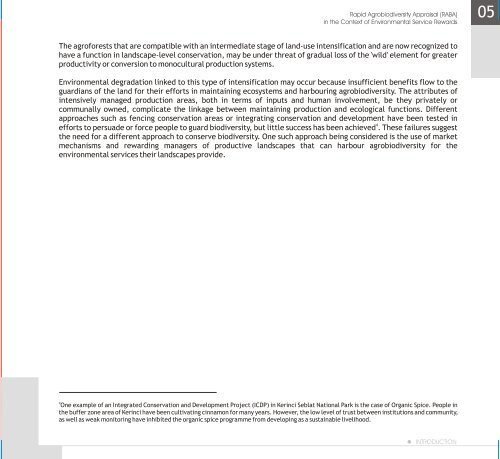Rapid Agrobiodiversity Appraisal (RABA) - Are you looking for one ...
Rapid Agrobiodiversity Appraisal (RABA) - Are you looking for one ...
Rapid Agrobiodiversity Appraisal (RABA) - Are you looking for one ...
Create successful ePaper yourself
Turn your PDF publications into a flip-book with our unique Google optimized e-Paper software.
<strong>Rapid</strong> <strong>Agrobiodiversity</strong> <strong>Appraisal</strong> (<strong>RABA</strong>)<br />
in the Context of Environmental Service Rewards<br />
The agro<strong>for</strong>ests that are compatible with an intermediate stage of land-use intensification and are now recognized to<br />
have a function in landscape-level conservation, may be under threat of gradual loss of the 'wild' element <strong>for</strong> greater<br />
productivity or conversion to monocultural production systems.<br />
Environmental degradation linked to this type of intensification may occur because insufficient benefits flow to the<br />
guardians of the land <strong>for</strong> their ef<strong>for</strong>ts in maintaining ecosystems and harbouring agrobiodiversity. The attributes of<br />
intensively managed production areas, both in terms of inputs and human involvement, be they privately or<br />
communally owned, complicate the linkage between maintaining production and ecological functions. Different<br />
approaches such as fencing conservation areas or integrating conservation and development have been tested in<br />
4<br />
ef<strong>for</strong>ts to persuade or <strong>for</strong>ce people to guard biodiversity, but little success has been achieved . These failures suggest<br />
the need <strong>for</strong> a different approach to conserve biodiversity. One such approach being considered is the use of market<br />
mechanisms and rewarding managers of productive landscapes that can harbour agrobiodiversity <strong>for</strong> the<br />
environmental services their landscapes provide.<br />
4 One example of an Integrated Conservation and Development Project (ICDP) in Kerinci Seblat National Park is the case of Organic Spice. People in<br />
the buffer z<strong>one</strong> area of Kerinci have been cultivating cinnamon <strong>for</strong> many years. However, the low level of trust between institutions and community,<br />
as well as weak monitoring have inhibited the organic spice programme from developing as a sustainable livelihood.<br />
INTRODUCTION

















![CynefinFramework final [Read-Only]](https://img.yumpu.com/19017304/1/190x135/cynefinframework-final-read-only.jpg?quality=85)